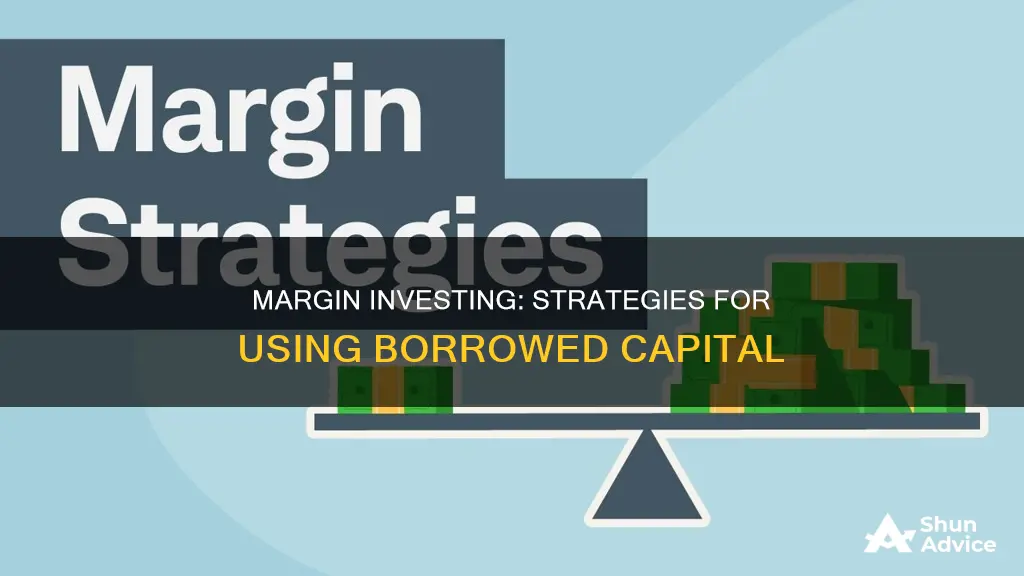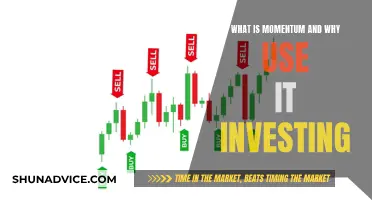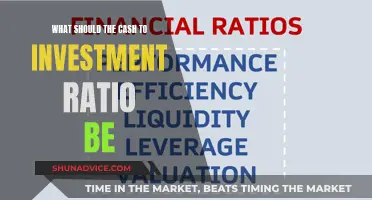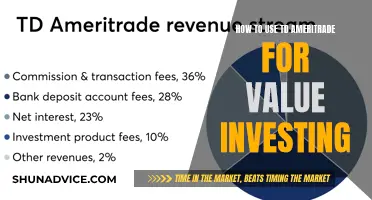
Margin investing is a way to amplify your gains when investing in stocks. It involves borrowing money from a broker to purchase stock, which is then used to buy more stock than you could normally afford. This strategy can be risky as it can also amplify your losses.
Margin investing is best left to professionals as it requires a high level of risk tolerance and the potential for significant financial loss. It is important to understand the risks and implications of margin investing before considering this strategy.
| Characteristics | Values |
|---|---|
| Definition | Margin trading, or “buying on margin,” means borrowing money from your brokerage company, and using that money to buy stocks. |
| Collateral | The value of the assets held in an investor’s account — including cash and any investments such as stocks and mutual funds — serves as collateral for the loan. |
| Credit limit | Typically a broker will permit an investor to borrow up to 50% of the purchase price of a stock up to whatever the amount in collateral is in the account. |
| Interest | The brokerage sets the interest rate for the loan by establishing a base rate and either adding or subtracting a percentage based on the size of the loan. |
| Maintenance requirements | Investors must maintain a minimum level of cash and securities in their account, or the broker’s “maintenance level”. |
| Margin call | If the value of those securities dips and the collateral falls below the maintenance level, the broker will issue a “margin call”. |
| Risk | With the potential for higher returns, there’s also more risk. |
What You'll Learn

Margin trading risks and rewards
Margin trading is a financial strategy that can amplify both gains and losses. It involves borrowing money from a broker to trade in financial assets, with the investment itself used as collateral for the loan. This strategy is best left to professionals as it carries significant risks.
Risks
Margin trading is a risky strategy due to the potential for amplified losses. If investments underperform, investors can lose more money than they initially put in. A decline in the value of investments can also lead to a margin call, where the broker demands more funds to be added to the account. If the investor cannot meet this demand, the broker can liquidate the account without approval, resulting in potential losses.
The volatility of markets means that even slight fluctuations can have significant consequences for investors using margin trading. Interest rates on margin loans can also increase costs and affect profitability.
Rewards
Margin trading can lead to higher rewards by allowing investors to leverage their capital and make larger investments. It increases buying power, enabling investors to diversify their portfolios and take advantage of market changes. It also provides faster and easier liquidity, allowing investors to access cash instantly.
Margin trading is a high-risk, high-return strategy that demands a disciplined approach and a thorough understanding of the potential risks. While it can lead to amplified gains, it can also result in significant losses. Therefore, it is essential for investors to carefully consider the risks and costs before engaging in margin trading.
Cashing Out Refinance: A Smart Investment Move?
You may want to see also

Margin account vs cash account
When it comes to investing, the type of brokerage account you choose can have a significant impact on your trading strategy, potential returns, and level of risk. Two of the most common account types are cash accounts and margin accounts. While both provide access to financial markets, they are based on fundamentally different principles and have distinct advantages and disadvantages.
Cash Accounts
Cash accounts are the more straightforward option. They limit you to investing only the money you have, which aligns with the adage "don't spend what you don't have" and provides a clear boundary for your trading. Transactions through cash accounts must be paid in full by the settlement date, typically one business day after an order is placed. Cash accounts are suitable for beginners, hands-off traders, and investors with low-risk tolerance.
#### Advantages of Cash Accounts:
- Simplicity: Trades are limited by the cash in the account, and complicated trades like short positions are not possible. There is also no risk of accidentally taking on too much debt.
- Allows for buy-and-hold: Investors can hold securities whether they rise or fall in value without being forced to sell.
- Earn interest: Money that is not invested can be kept in a money market account and can earn interest.
#### Disadvantages of Cash Accounts:
- Fewer types of trades available: Cash accounts may not allow for trading options, opening short positions, or certain types of futures.
- Balance limits potential returns: Investing only the cash available means lower potential returns compared to using margin.
- Lower potential returns: Without the use of leverage, the return potential is lower than with margin accounts.
Margin Accounts
Margin accounts, on the other hand, introduce the concept of leverage, allowing investors to borrow funds from their broker to purchase securities. This can amplify potential gains but also increases risk and complexity. Margin accounts are powerful tools for experienced investors who fully understand their mechanics and risks. Margin accounts are suitable for investors with more market expertise and higher risk tolerance.
#### Advantages of Margin Accounts:
- Higher potential returns: Borrowing money to invest allows for larger investments and higher returns.
- Access to more complex securities: Margin accounts provide access to futures, options, and other more advanced securities, enabling more sophisticated investment strategies.
- Secure loans with your portfolio: Margin accounts are an easy way to borrow against your portfolio, and the amount that can be borrowed often increases as the portfolio grows.
#### Disadvantages of Margin Accounts:
- Higher potential losses: Borrowing money to invest also increases the potential for larger losses. In the worst-case scenario, losses can exceed the amount in the account.
- Minimum balance requirements: Many brokerages require minimum balances, often in the thousands of dollars, to open a margin account.
- Margin calls and forced sales: If the value of securities purchased with margin money decreases, the account may fall below the broker's required equity level, leading to a margin call. If this happens, investors may be forced to sell at a loss.
In summary, cash accounts are generally best for long-term investments and buy-and-hold investors, while margin accounts are better suited for those who make more frequent trades and are comfortable with higher risk and increased complexity.
Cash App Investing: FDIC Insured?
You may want to see also

Margin calls and how to avoid them
A margin call is a demand from your broker to increase the amount of equity in your account. This happens when the percentage of an investor's equity in a margin account falls below the brokerage's pre-agreed maintenance amount.
To avoid margin calls, it is important to understand what triggers them and take steps to minimize the risk. Here are some strategies to avoid margin calls:
- Monitor your account regularly: Keep a close eye on the equity levels in your margin account, especially during periods of extreme market volatility. Set up alerts to notify you when the value of your stock declines significantly.
- Prepare for volatility: Maintain a considerable cash cushion in your account to protect against sudden drops in the value of your loan collateral.
- Set a personal trigger point: Keep additional liquid resources readily available in case you need to quickly add money or securities to your margin account.
- Understand margin requirements: Before placing any orders, know the margin requirements for each position you plan to enter. Account for the margin amount that will be deducted from your free margin, and have additional margin to give your trade some breathing room.
- Use stop-loss orders: Utilize stop-loss orders or trailing stops to limit losses and prevent further losses, which can help avoid margin calls.
- Scale in positions: Instead of entering a large position all at once, build your trade position over time. Start with a smaller position and add to it as the price moves in your favor. This reduces the probability of triggering a margin call.
- Diversify your portfolio: A well-diversified portfolio can help limit margin calls as it is less likely that a single position will decrease the account value.
- Have cash readily available: Ensure you have cash available to place in your account immediately if needed. Consider keeping it in an interest-earning account at the same brokerage.
- Use protective stop orders: In addition to maintaining adequate cash and securities in your account, use protective stop orders to limit losses in any equity positions.
By implementing these strategies, you can reduce the likelihood of receiving a margin call and minimize the potential financial stress and implications associated with it.
How Much Cash Should You Invest?
You may want to see also

How to buy on margin
Margin trading is a risky strategy that involves borrowing money from a broker to purchase investment assets, usually stocks or bonds. It amplifies your buying power, allowing you to invest more and potentially earn greater returns. However, it is important to remember that any losses will also be amplified.
Step 1: Open a Margin Account
You will need to open a margin account with a broker. This is different from a regular cash account as it allows you to purchase assets beyond your cash account balance. By law, your broker is required to obtain your signature to open a margin account. The minimum initial investment for a margin account is $2,000, although some brokerages require more.
Step 2: Fund Your Account
Most margin accounts have minimum funding requirements. You will need to fund your account by depositing cash or transferring margin-eligible securities (typically stocks that trade on major indices, not penny stocks).
Step 3: Determine Your Buying Power
Your buying power is determined by the equity in your account and the margin requirements of the brokerage. For example, if you funded your account with $3,000 and your brokerage requires a 30% margin, you would have a maximum buying power of $10,000.
Step 4: Make a Purchase
Once you make a purchase, you will owe interest on the money you borrowed. The amount of interest you pay is based on the interest rate, the amount borrowed, and the length of time you borrow the money.
Step 5: Maintain Your Account
You must maintain a minimum account balance, known as the maintenance margin. If the value of the securities in your account decreases and you fall below this minimum, your brokerage will issue a margin call, requiring you to fund your account by depositing cash or margin-eligible securities.
Step 6: Sell Your Position
When you instruct your brokerage to sell your position, it will sell the securities, pay itself back the outstanding loan value and any interest charges, and pass the remaining balance on to you.
It is important to remember that buying on margin is a high-risk strategy and may not be suitable for all investors. The potential for greater returns is accompanied by the possibility of greater losses.
Where Should Your Cash Be Held?
You may want to see also

Pros and cons of margin investing
Margin investing can be a risky strategy, but it can also amplify profits. Here is a list of the pros and cons of margin investing:
Pros:
- Maximised potential returns: The greatest advantage of margin investing is that it boosts your purchasing power and can be used to multiply your returns.
- More trading opportunities: Margin investing gives you more options for investing and allows you to employ more advanced strategies.
- Tax benefits: Interest on margin loans is usually tax-deductible against your net investment income.
- Faster and easier liquidity: Margin accounts allow investors to transfer money faster and access cash instantly.
Cons:
- Increased risk: Margin investing can lead to greater losses as well as greater gains. If the value of your investments declines, you may be forced to deposit additional capital or sell off stocks to cover your margin.
- Additional costs: There are interest expenses and account fees associated with margin investing.
- Forced liquidations: If you are unable to meet a margin call, your brokerage firm may liquidate your stocks, potentially resulting in losses.
- Complexity: Margin investing is a complex strategy that may not be suitable for beginners or risk-averse investors.
- Domino effect: Significant margin calls on a single major investor may decrease the value of securities held as collateral by other margin traders, putting them at risk of a margin call.
Life Insurance Investments: Strategies for Financial Growth
You may want to see also
Frequently asked questions
Margin investing is when an investor borrows money from a broker to purchase an asset, with the investor's current cash or securities in their account acting as collateral for the loan.
Margin investing can magnify an investor's profits. For example, if an investor puts up $5,000 of their own money to buy shares and borrows $5,000 from their broker, they will make double the profit they would have made if they had only invested their own money.
Margin investing can also magnify an investor's losses. If the value of the shares purchased with the broker's loan falls, the investor will lose more money than if they had only invested their own money. In addition, the broker may issue a margin call, demanding that the investor deposits more funds or sells off some of their holdings to pay down the loan.







